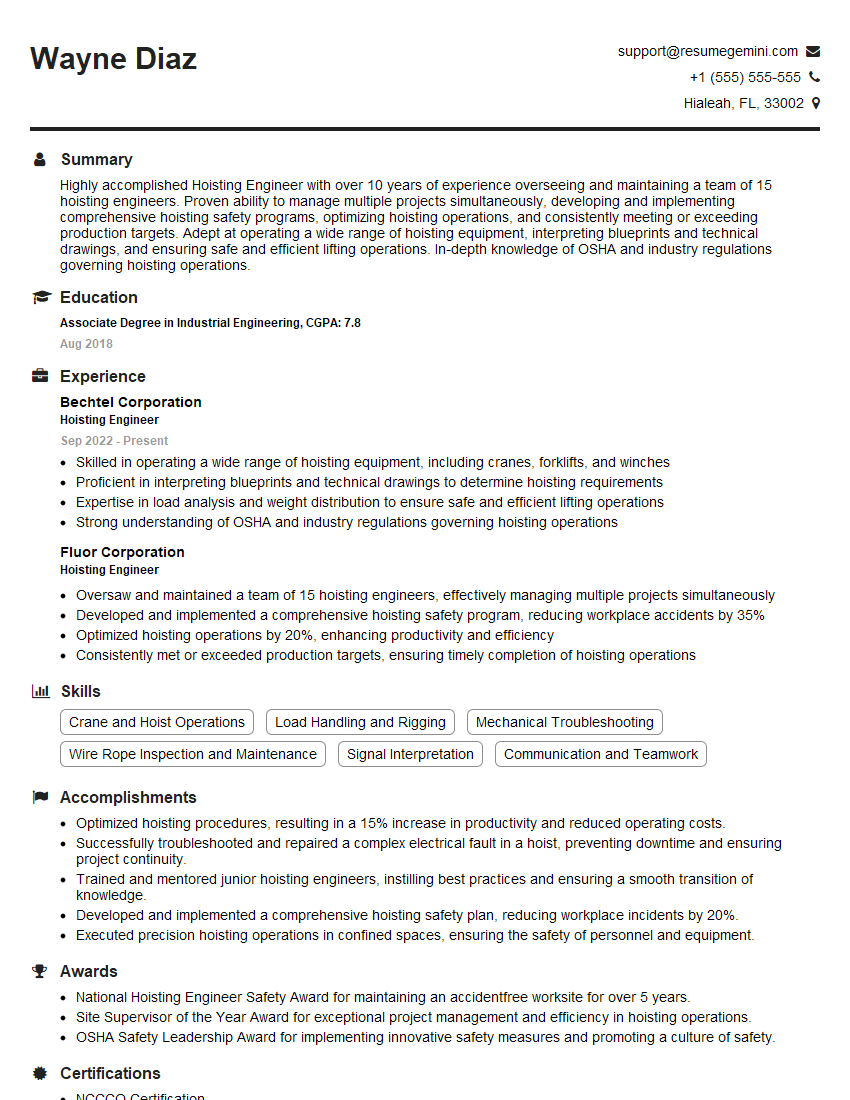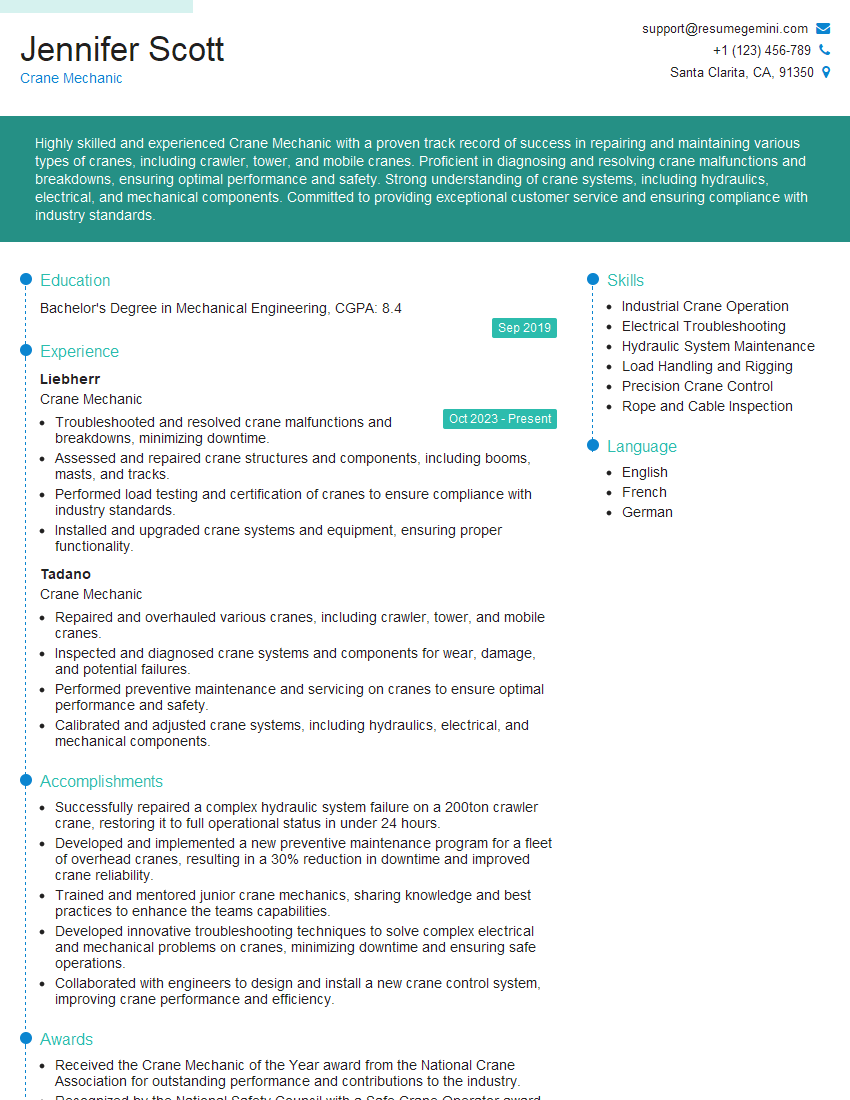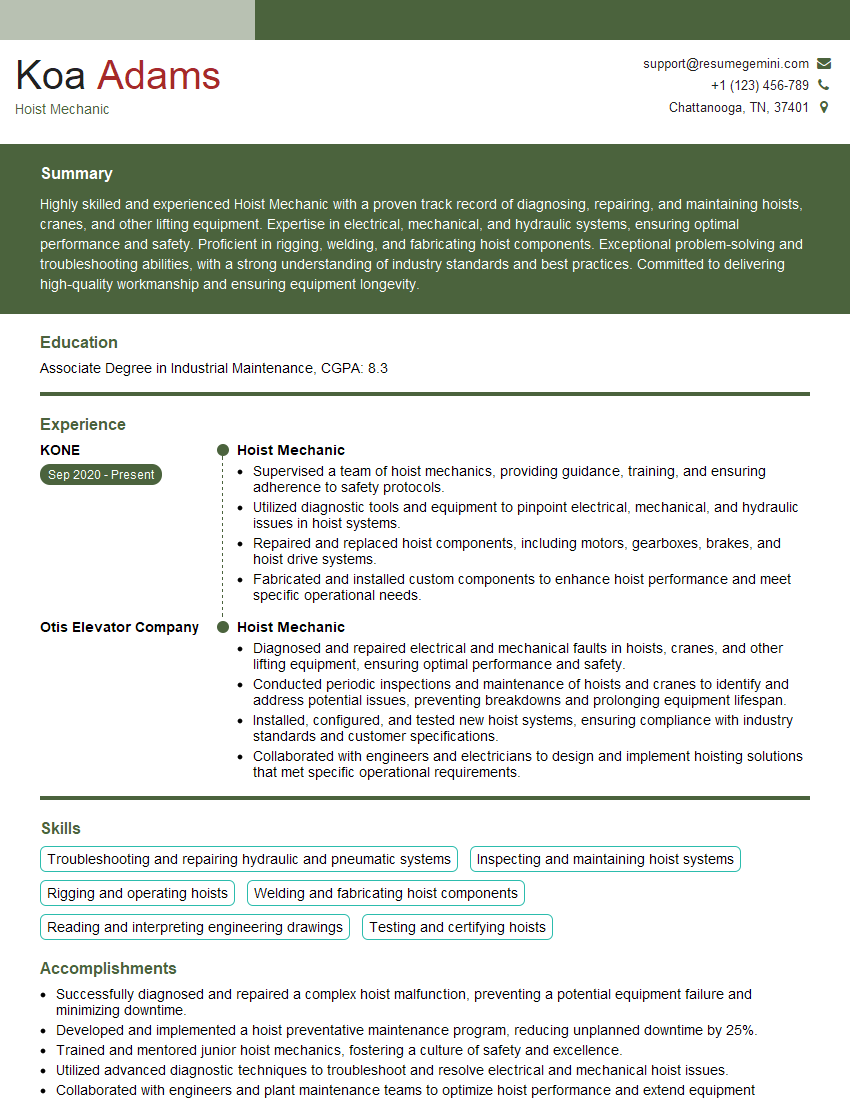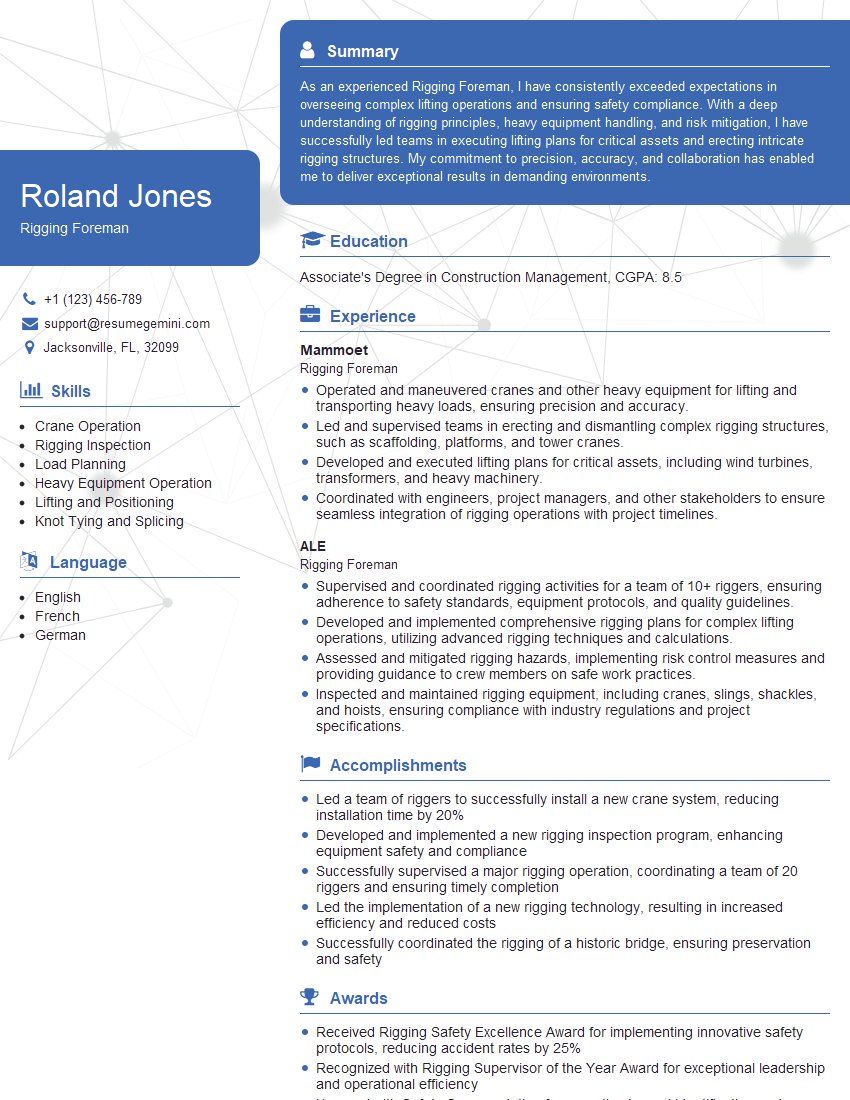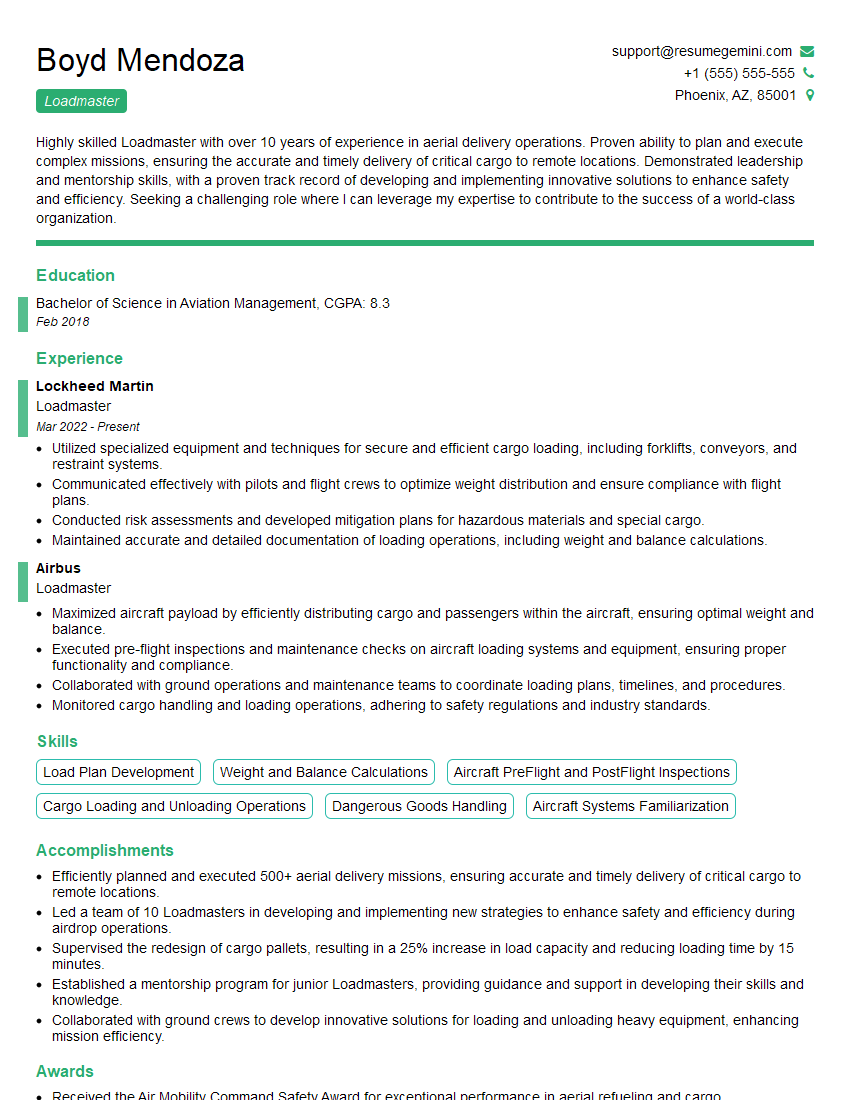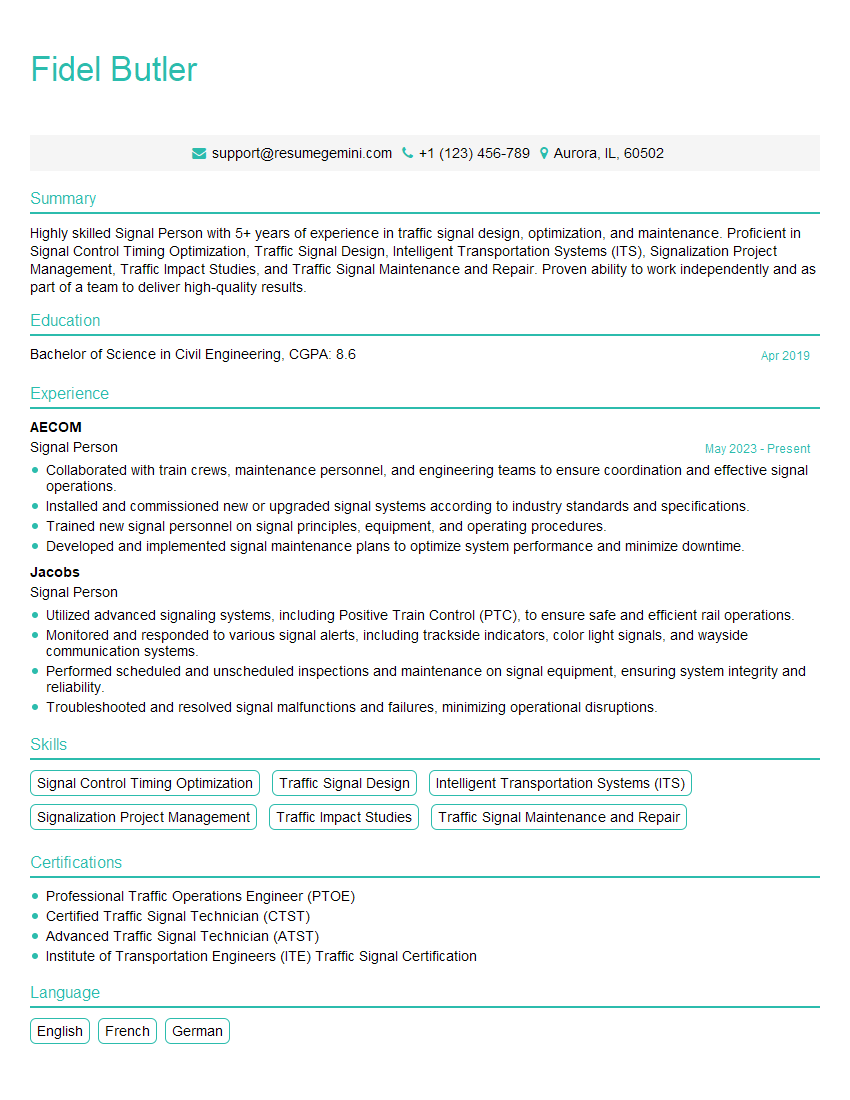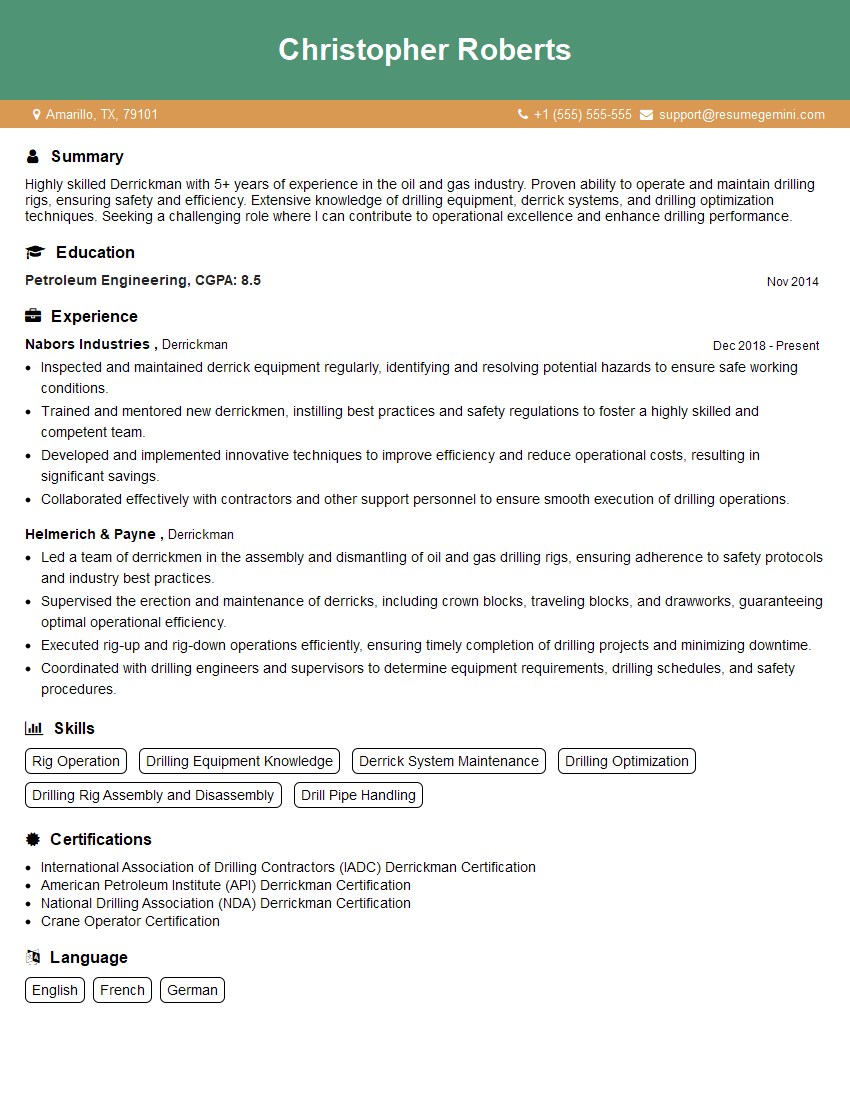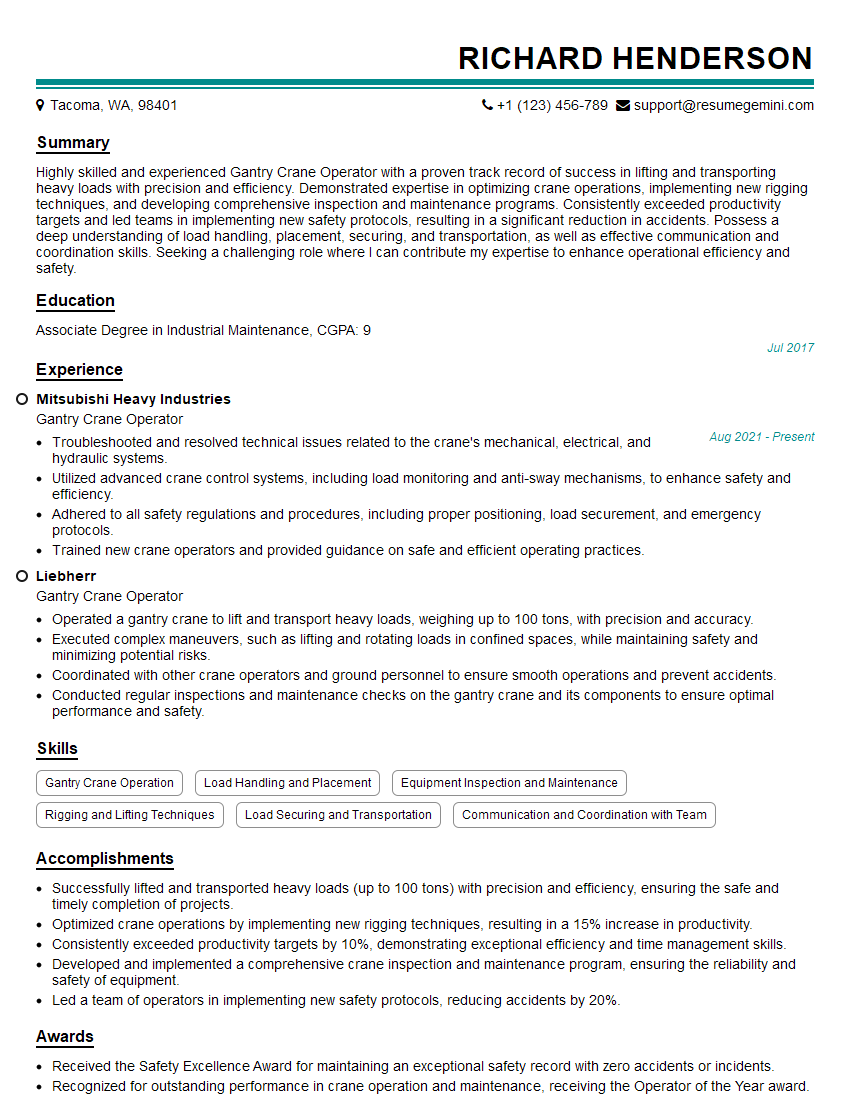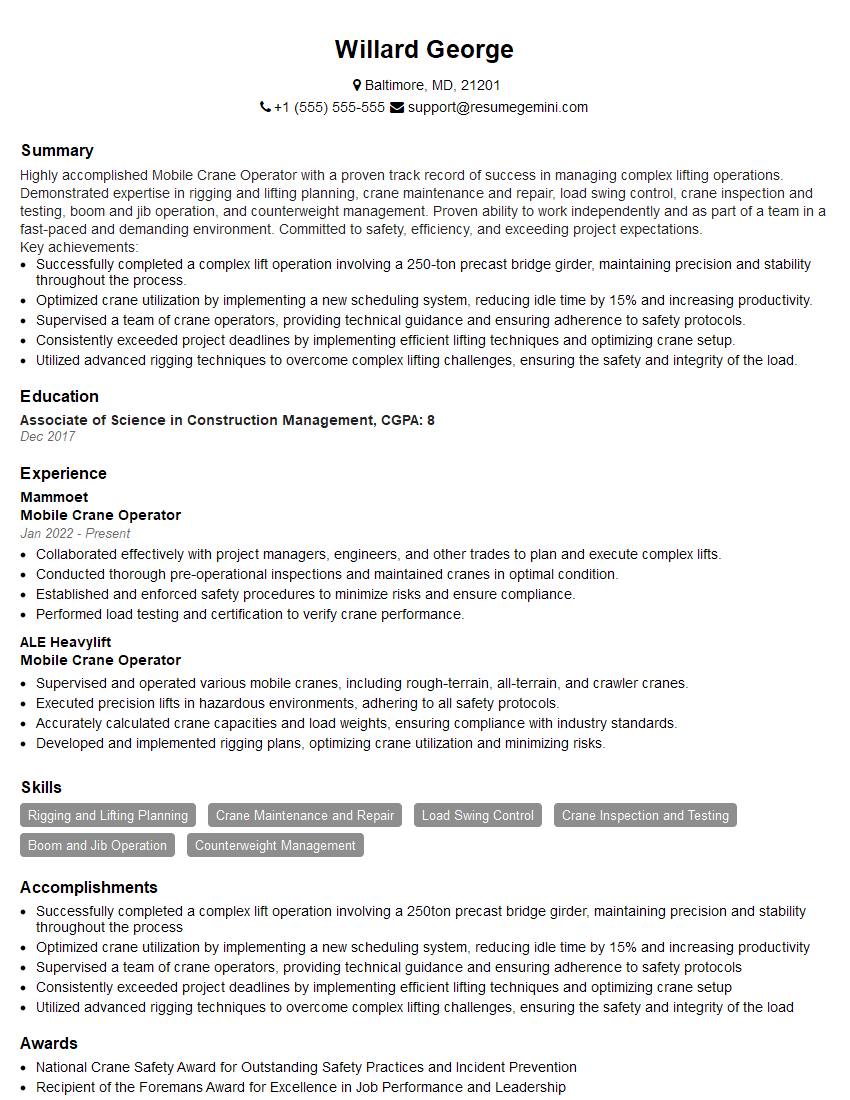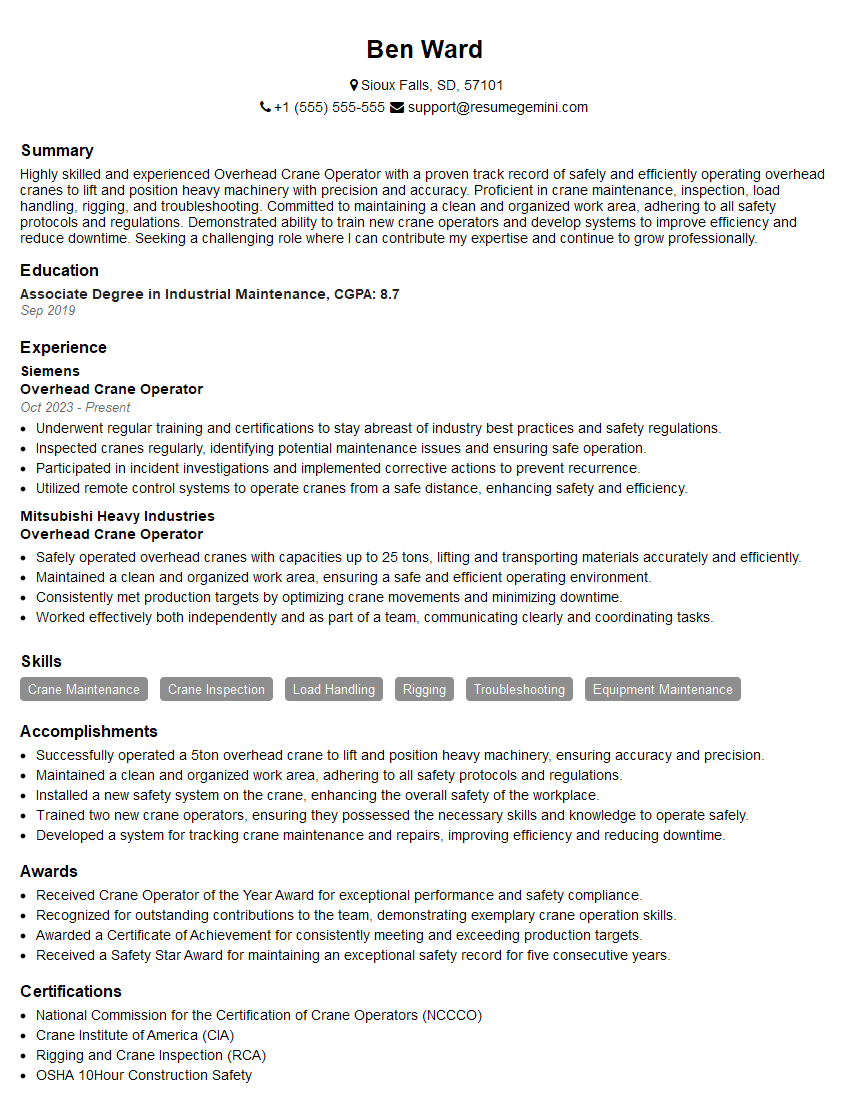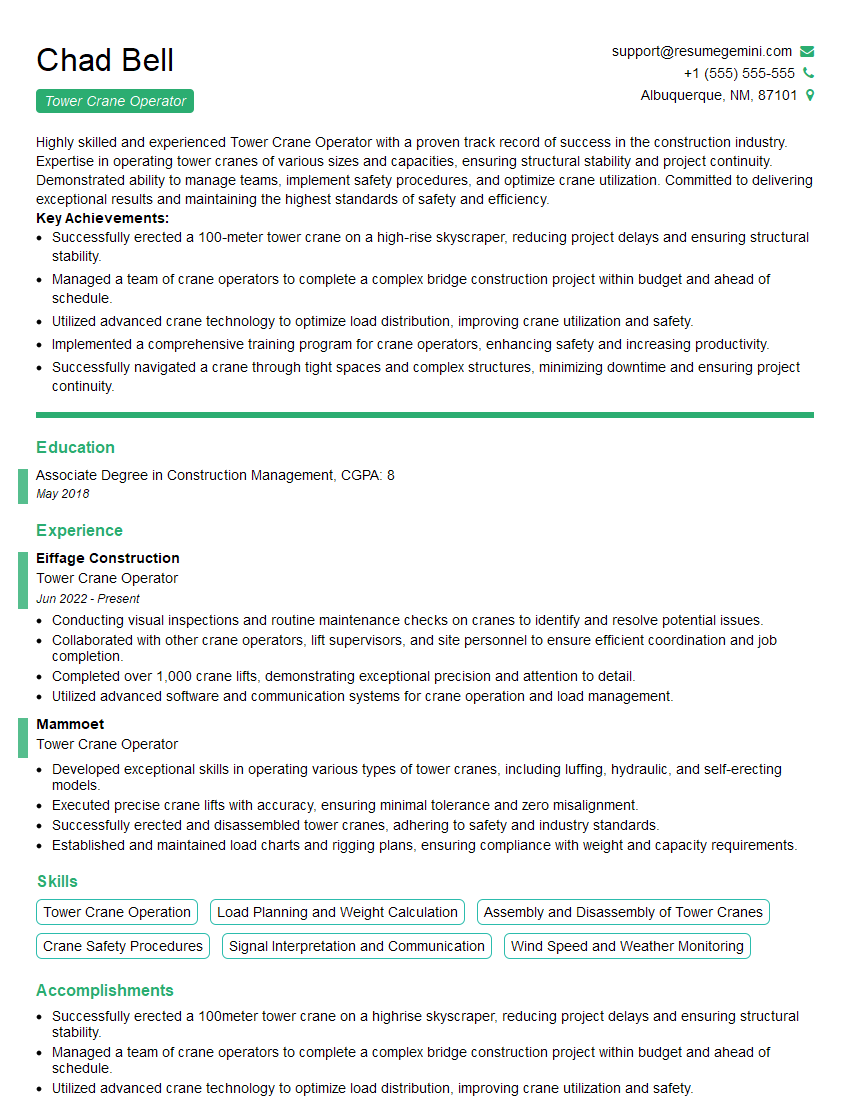Preparation is the key to success in any interview. In this post, we’ll explore crucial Crane and Hoisting Operations interview questions and equip you with strategies to craft impactful answers. Whether you’re a beginner or a pro, these tips will elevate your preparation.
Questions Asked in Crane and Hoisting Operations Interview
Q 1. Explain the different types of crane hooks and their applications.
Crane hooks are crucial components, and their design directly impacts safety and efficiency. Different hook types are designed for specific lifting tasks and load characteristics.
- Single-leg hooks: These are the most common type, simple in design and suitable for general lifting. Think of the classic hook shape you often see on smaller cranes.
- Clevis hooks: These have a clevis (a U-shaped metal piece) at the end instead of a simple hook point. This allows for easy attachment of shackles or other lifting devices. They are commonly used when a more robust connection is required or for easier changing of lifting attachments.
- Grab hooks: Designed specifically for grabbing and lifting irregularly shaped objects, these hooks are often found on specialized lifting equipment. Think of lifting scrap metal or bundles of material where you need a secure grip.
- Alloy steel hooks: These are usually stronger and more durable than carbon steel hooks, making them ideal for heavy-duty lifting applications or harsh environments.
The choice of hook depends on the load’s weight, shape, and material. A lightweight single-leg hook wouldn’t be suitable for a heavy steel beam; a clevis hook might be a more appropriate option in such case. Selecting the wrong hook type can lead to serious accidents.
Q 2. Describe the process of pre-operational crane inspection.
A pre-operational crane inspection is a critical safety procedure that must be performed before every use. It’s a systematic check to ensure the crane is in safe working order and identify any potential hazards. The process typically involves:
- Visual inspection: Checking for any visible damage to the crane structure, boom, hook, wires, and all moving parts. Look for cracks, bends, corrosion, wear, and any signs of previous damage.
- Mechanical inspection: Testing the functionality of all mechanical components such as brakes, hoisting mechanisms, slewing systems, and limit switches. This includes checking that the brakes engage and release smoothly.
- Electrical inspection: Inspecting all electrical components, including wiring, motors, control systems, and emergency stop buttons to ensure they are working correctly. This is crucial for the safe operation of electrically powered mechanisms.
- Hydraulic inspection (if applicable): Checking for leaks, proper fluid levels, and the overall condition of hydraulic cylinders, pumps, and hoses. Hydraulic systems often require regular maintenance to prevent failures.
- Documentation: Recording all findings in a standardized inspection checklist. Any issues identified must be reported and rectified before the crane is used.
Imagine a scenario where a crack goes unnoticed during inspection and the crane is operated; it could lead to a catastrophic failure and injury. A thorough pre-operational inspection is an investment in safety.
Q 3. What are the limitations of a mobile crane?
Mobile cranes, while versatile, have several limitations that must be considered for safe and effective operation:
- Ground conditions: The stability of the crane is directly influenced by the ground’s bearing capacity. Soft or uneven ground can limit the crane’s lifting capacity and increase the risk of tipping.
- Outriggers and stability: Mobile cranes rely on outriggers for stability when lifting heavy loads. The positioning and extension of outriggers is crucial. Inadequate outrigger placement compromises stability.
- Reach and lifting capacity: The maximum reach and lifting capacity of a mobile crane decreases as the boom is extended. Attempting to lift a heavy load at maximum reach greatly increases the risk of an overturn.
- Wind speed and direction: High wind speeds can significantly affect the stability of the crane, reducing the safe working load and potentially causing the crane to overturn. Wind is a serious limitation, requiring careful consideration.
- Swing radius: The swing radius of the crane (the area the crane can rotate within) must be carefully considered to prevent collisions with nearby objects or people. Clearance and site planning are key.
For example, operating a mobile crane on a slope without proper ground stabilization and calculation of the reduced lifting capacity is extremely hazardous and can easily lead to accidents.
Q 4. How do you calculate the safe working load of a crane?
Calculating the safe working load (SWL) of a crane isn’t a simple calculation; it’s a complex process involving several factors. The SWL is the maximum load a crane can safely lift under specific conditions, which depends on many variables.
It’s crucial to always refer to the crane’s load chart. This chart provides the safe working load for different boom lengths, radii, and angles. Using the chart, you can determine the SWL for a specific lifting configuration.
Factors affecting SWL:
- Boom length and radius: Longer boom lengths and greater radii reduce the SWL.
- Boom angle: The angle of the boom also influences the SWL; certain angles are more stable than others.
- Wind speed: High wind speeds significantly decrease the SWL.
- Ground conditions: As mentioned before, soft ground reduces stability, affecting the SWL.
- Crane model and configuration: Different crane models and configurations have different SWL limits.
Never exceed the SWL indicated on the crane’s load chart. Doing so risks serious accidents.
Q 5. What are the different types of crane booms and their uses?
Crane booms are essential for extending the crane’s reach and lifting capacity. Several types exist, each designed for specific applications:
- Lattice boom: This type is common in larger cranes and consists of a triangular framework of interconnected members. They are strong and relatively lightweight but can be more complex to assemble and disassemble.
- Telescopic boom: These booms are made up of several sections that can be extended or retracted hydraulically. This allows for variable reach without the need for reconfiguration. They’re easier to handle than lattice booms and very popular in mobile cranes.
- Heavy-lift boom: Designed for extremely heavy lifting, these booms are usually very sturdy and have a high load capacity. This is used for things like lifting large construction components.
- Fixed jib boom: A jib is a shorter boom that is mounted on a main boom. This provides additional reach and lifting capacity in a specific direction. It is usually a fixed attachment.
- Luffing jib boom: This type of jib is able to adjust its angle, providing flexibility in how it interacts with the main crane boom and the load.
The selection of the boom type depends on the specific requirements of the lifting task, considering factors such as the weight of the load, the required reach, and the overall stability.
Q 6. Explain the importance of load charts and how to interpret them.
Load charts are indispensable for safe crane operations. They visually represent the safe working load (SWL) of a crane under various conditions. They are essentially a graphical representation of the crane’s lifting capabilities under specific constraints. Understanding and using a load chart correctly is paramount for safety.
Interpreting a load chart: Most load charts use a series of curves or tables to show the SWL. These are usually plotted against the boom length and radius. Each curve or table might represent different boom angles or wind conditions.
Example: A typical chart would show that with a 50-meter boom length and a 20-meter radius, the SWL is 10 tons in calm conditions. However, at the same boom length and radius, the SWL might drop to 7 tons if the wind speed exceeds 20km/h.
Importance: Before any lift, always consult the load chart and ensure that the planned lift is within the safe parameters. Using the chart helps prevent overloads and potential accidents.
Q 7. Describe the different types of crane signals and their meaning.
Effective communication between the crane operator and the signal person is crucial for safe lifting operations. Standardized hand signals are universally used to direct the crane operator.
Common Crane Signals:
- Hoist/Lower: A vertical hand motion indicates hoisting (lifting) or lowering the load.
- Swing (left/right): A circular hand motion directs the crane to swing the load left or right.
- Travel (forward/reverse): A hand motion indicating forward or backward movement.
- Emergency Stop: A rapid, downward movement of both arms signals an immediate stop.
- Raise/Lower Boom: Specific hand signals indicate adjustments to the boom angle.
- Extend/Retract Boom: Signals to extend or retract a telescopic boom.
These signals, along with the use of radios, ensure a clear understanding between operator and signal person. Inaccurate or unclear signals can result in accidents. Proper training and clear understanding of signals are essential for everyone involved in crane operations. Remember, effective communication is critical.
Q 8. How do you ensure the stability of a crane during operation?
Ensuring crane stability is paramount for safe operation. It involves a multifaceted approach focusing on the crane’s structural integrity, the load being lifted, and the environmental conditions.
- Proper Ground Conditions: The crane’s base must be on a level, stable, and adequately compacted surface capable of supporting the crane’s weight plus the maximum load. Think of it like building a house – you wouldn’t build on shifting sand! Uneven ground can lead to instability and tipping.
- Load Distribution: The weight of the load needs to be evenly distributed within the crane’s capacity. This includes understanding the load’s center of gravity. Imagine lifting a long, narrow beam – you wouldn’t want to grab it at one end because it would be very unstable. Proper rigging and load securing are crucial here.
- Wind Speed and Direction: High winds pose a significant risk. Crane operators need to consult wind speed charts and adhere to the manufacturer’s specified limits. High winds can create an unbalanced force on the load and the crane itself.
- Regular Inspections: Before each operation, a thorough inspection of the crane’s structure, brakes, and mechanisms is essential to ensure everything is in optimal working condition. This is akin to a pre-flight check on an airplane – vital for safety.
- Outriggers (for mobile cranes): For mobile cranes, properly extending and setting outriggers significantly improves stability, expanding the crane’s base and increasing its resistance to tipping.
Ignoring these factors can lead to catastrophic accidents, emphasizing the importance of a rigorous and proactive approach to crane stability.
Q 9. What are the common causes of crane accidents?
Crane accidents are often the result of multiple contributing factors, but some common causes include:
- Human Error: This is the leading cause, encompassing negligence, inadequate training, poor judgment, and fatigue. For example, exceeding the crane’s weight capacity or improper rigging techniques are serious human errors.
- Equipment Failure: Mechanical failure of components such as brakes, cables, or the hoisting mechanism can lead to accidents. Regular maintenance and inspections are critical to prevent such failures. Think of it like regular car maintenance; neglecting it can lead to breakdowns.
- Environmental Factors: Severe weather conditions like strong winds or heavy rain can significantly impact crane stability and operation. Operating under unsafe weather conditions can have devastating consequences.
- Inadequate Planning: Failure to properly plan a lift, including assessing the load, the work area, and potential hazards, can result in accidents. Planning should cover every aspect, considering all possible scenarios and preventative measures.
- Lack of Communication: Miscommunication between the crane operator, riggers, and ground crew can lead to serious accidents. Clear and concise communication is vital on every construction site.
Addressing these contributing factors through rigorous training, meticulous maintenance, and effective safety protocols is crucial to minimizing the risk of crane accidents.
Q 10. How do you handle an emergency situation during crane operation?
Handling emergencies during crane operations requires a calm and decisive approach. The first priority is always safety – both for the operator and those in the vicinity.
- Immediate Shutdown: The first step is to immediately shut down the crane using the emergency stop mechanism.
- Assess the Situation: Quickly determine the nature of the emergency – is it a mechanical failure, a load instability, or a collision?
- Evacuate the Area: Clear the area around the crane to prevent further injuries. Warn others of the emergency using designated signals or communication methods.
- Contact Emergency Services: Depending on the severity of the situation, call emergency services and relevant authorities immediately.
- Secure the Load (if possible): If the situation allows and it is safe, attempt to stabilize or secure the load to prevent further problems.
- Conduct a Post-Incident Investigation: Once the emergency is over, a thorough investigation is critical to determine the cause of the accident and prevent similar events in the future.
Regular training and drills are essential to prepare for such situations. Emergency response plans must be well-defined and understood by all personnel involved in crane operations.
Q 11. Describe your experience with different types of lifting equipment.
My experience encompasses a wide range of lifting equipment, including:
- Tower Cranes: Extensive experience in operating and maintaining various types, including hammerhead and luffing jib cranes, on large-scale construction projects.
- Mobile Cranes: Proficient in operating different mobile crane models, understanding their load charts, and performing pre-operational checks.
- Overhead Cranes: Familiar with different overhead crane systems, including bridge cranes, gantry cranes, and jib cranes, in both industrial and manufacturing settings.
- Forklifts: Experienced in safe forklift operation, adhering to weight limits, and understanding load stability principles.
- Hoists: Experienced with various types of hoists, including chain hoists and electric hoists, including proper maintenance and safety procedures.
This diverse experience allows me to adapt to different lifting situations and choose the most appropriate equipment for specific tasks, always prioritizing safety and efficiency.
Q 12. What are the safety regulations related to crane operation?
Crane operation is governed by a comprehensive set of safety regulations that vary slightly by location but generally include:
- Regular Inspections and Maintenance: Cranes must undergo regular inspections and maintenance by qualified personnel to ensure they are in safe working order. This follows strict schedules and documentation requirements.
- Operator Certification and Training: Crane operators must be properly certified and trained to operate the specific type of crane they are using. This training emphasizes safe operating procedures and emergency response.
- Load Capacity Limits: Operators must never exceed the crane’s rated load capacity. Load charts must be consulted before each lift.
- Safe Working Loads (SWL): Rigging equipment, such as slings and shackles, must also be within their SWL for the specific load.
- Pre-Lift Planning: A comprehensive risk assessment and lifting plan should be developed for every lift, especially complex operations.
- Site Safety Regulations: Compliance with all site-specific safety rules and regulations is mandatory. This often includes designated signal persons and safe working zones.
- Emergency Procedures: Clear and established emergency procedures must be in place and understood by everyone on site. Drills should be regularly conducted to enhance preparedness.
Adherence to these regulations is non-negotiable to ensure safe and responsible crane operation.
Q 13. Explain the concept of swing radius and its importance.
The swing radius refers to the horizontal distance from the crane’s center of rotation to the furthest point reached by the load during a swing. It’s a critical safety parameter because it defines the area within which the load could potentially swing and strike objects or personnel.
Importance:
- Obstacle Avoidance: Knowing the swing radius allows for proper planning to avoid obstacles such as buildings, equipment, or personnel within the crane’s operational area. Think of it like the turning radius of a car; you wouldn’t turn sharply in a tight space.
- Safety Zones: The swing radius defines the necessary safety zones around the crane, ensuring that unauthorized personnel are kept at a safe distance during operation.
- Preventing Collisions: Understanding and respecting the swing radius helps prevent collisions between the load and other structures or objects.
- Crane Stability: The swing radius is directly related to the crane’s stability, as excessive swing can increase the risk of tipping or instability.
Ignoring the swing radius is a recipe for accidents; proper planning and awareness are essential for preventing such incidents.
Q 14. How do you plan a complex lifting operation?
Planning a complex lifting operation requires a methodical approach that leaves no room for error. It’s like orchestrating a symphony – each instrument (piece of equipment) must play its part in perfect harmony.
- Detailed Site Survey: A comprehensive assessment of the site, including ground conditions, obstacles, access routes, and environmental factors. This includes measuring distances and creating site maps.
- Load Analysis: Determine the weight, center of gravity, dimensions, and any peculiarities of the load. This could include using specialized software to calculate stress points and safe lifting angles.
- Crane Selection: Choose the most appropriate crane based on the load’s weight, dimensions, and the site’s constraints. Consider reach, lifting capacity, and maneuverability.
- Rigging Plan: Develop a detailed rigging plan, including the type of slings, shackles, and other rigging equipment to be used. This must account for load stability and safe angles.
- Lifting Procedure: Outline a step-by-step lifting procedure, including communication protocols between the crane operator, riggers, and ground crew. This should define each movement and safety checkpoints.
- Risk Assessment: Identify and mitigate potential hazards during the lifting operation, including emergency plans in case of failure.
- Review and Approvals: The lifting plan should be reviewed and approved by qualified personnel before the operation commences. This ensures everybody understands the plan and agrees it’s safe.
Thorough planning is the key to a successful and safe complex lift, minimizing risk and ensuring efficiency. Skipping steps or rushing the process can have severe consequences.
Q 15. What is the role of a signal person?
The signal person plays a crucial role in ensuring safe crane operations. They are the eyes and ears of the crane operator, communicating hand signals or using a radio to direct the crane’s movements during lifting and placing operations. Their primary responsibility is preventing accidents by providing clear and concise directions and warnings to the operator.
Think of them as the air traffic controller of a construction site, guiding the crane operator to maneuver the load precisely and safely, avoiding obstacles and personnel. Their understanding of hand signals, load limitations, and the overall worksite environment is paramount. A good signal person anticipates potential hazards and communicates them effectively to the operator, often preventing near misses.
- Clear Communication: They must be able to communicate effectively, even in noisy environments.
- Situational Awareness: They must maintain constant awareness of the surroundings, load, and the crane’s movements.
- Knowledge of Safety Procedures: They need a solid understanding of crane safety regulations and emergency procedures.
Career Expert Tips:
- Ace those interviews! Prepare effectively by reviewing the Top 50 Most Common Interview Questions on ResumeGemini.
- Navigate your job search with confidence! Explore a wide range of Career Tips on ResumeGemini. Learn about common challenges and recommendations to overcome them.
- Craft the perfect resume! Master the Art of Resume Writing with ResumeGemini’s guide. Showcase your unique qualifications and achievements effectively.
- Don’t miss out on holiday savings! Build your dream resume with ResumeGemini’s ATS optimized templates.
Q 16. Describe your experience with troubleshooting crane malfunctions.
Troubleshooting crane malfunctions requires a systematic approach and a deep understanding of the crane’s mechanical, electrical, and hydraulic systems. My experience includes diagnosing issues ranging from simple hydraulic leaks to complex electrical faults in various crane types, including tower cranes, overhead cranes, and mobile cranes.
For instance, I once encountered a situation where a tower crane’s hoist mechanism suddenly stopped functioning. My troubleshooting process began with a visual inspection for obvious signs of damage. I then checked the power supply, hydraulic pressure, and the control system, systematically eliminating potential causes. The issue eventually turned out to be a faulty pressure sensor in the hydraulic system. Replacing the sensor quickly restored the crane’s functionality. This highlights the importance of methodical troubleshooting; jumping to conclusions can lead to wasted time and potentially unsafe practices.
Other examples include addressing issues with faulty limit switches, malfunctioning brakes, and problems with the load moment indicator (LMI). In each case, my approach involved safety checks, careful diagnostics, and documentation of the repair process. I always prioritize safety and adhere strictly to manufacturer guidelines and industry best practices.
Q 17. What are the maintenance procedures for different types of cranes?
Maintenance procedures vary significantly depending on the type of crane and its specific components. However, a common thread is the emphasis on regular inspections, lubrication, and preventative maintenance.
- Tower Cranes: These require frequent inspections of the slewing mechanism, hoisting system, and structural components. Regular lubrication of moving parts is critical, as is checking for any signs of structural fatigue or wear. Thorough inspections after extreme weather events are essential.
- Overhead Cranes: These necessitate regular lubrication of the bridge and trolley mechanisms. Checks on the electrical components, braking systems, and end stops are equally vital. The runways and supporting structures should also be inspected for signs of damage or wear and tear.
- Mobile Cranes: These need routine maintenance checks on the engine, hydraulic system, and tires. Regular lubrication of the boom and hoist mechanisms is crucial. The outriggers and load-bearing components must also undergo careful inspection.
All crane types require detailed maintenance logs documenting inspections, repairs, and any issues discovered. These logs are crucial for tracking maintenance history and ensuring the crane remains safe and compliant with regulations.
Q 18. How do you ensure compliance with OSHA regulations?
Ensuring compliance with OSHA regulations is paramount in crane and hoisting operations. This involves a multifaceted approach that encompasses several key aspects:
- Regular Inspections: Conducting thorough and documented inspections of all cranes and rigging equipment to identify and rectify potential hazards.
- Operator Training and Certification: Ensuring that all crane operators are properly trained and certified to operate the specific cranes they’re using, adhering to OSHA’s stringent requirements.
- Pre-operational Checks: Implementing a strict pre-operational checklist for every crane lift to ensure that all safety mechanisms are functioning correctly. This checklist should be completed before each lift and documented.
- Proper Rigging and Load Handling: Using the correct rigging equipment for the load and ensuring that loads are handled safely and within the crane’s capacity. This includes proper load securing and balancing.
- Emergency Procedures: Developing and practicing emergency response plans to address potential accidents or malfunctions. This includes procedures for evacuating personnel and securing the crane in an emergency.
- Record Keeping: Maintaining accurate and up-to-date records of all inspections, maintenance, repairs, and operator certifications. These records are crucial for demonstrating compliance during audits.
Compliance isn’t a one-time task but an ongoing commitment to safety and responsibility. Regular training, proactive maintenance, and a culture of safety are all integral to meeting and exceeding OSHA’s standards.
Q 19. Explain the concept of load moment indicator (LMI).
A Load Moment Indicator (LMI) is a safety device that continuously monitors the crane’s load, radius, and boom angle to calculate the load moment – the force tending to tip the crane. It’s essentially a real-time safety net that prevents exceeding the crane’s safe working load (SWL). If the calculated load moment exceeds the crane’s capacity, the LMI system will sound an alarm, prevent further hoisting, or even shut down the crane completely.
Think of it as a sophisticated scale that doesn’t just weigh the load but also factors in its position relative to the crane. This is crucial because a lighter load at a greater radius can create the same load moment as a heavier load at a shorter radius, potentially causing the crane to tip. The LMI helps avoid this dangerous scenario. In practice, it’s a critical safety feature found in modern cranes, minimizing the risk of crane overturning incidents.
Q 20. How do you select the appropriate crane for a given task?
Selecting the appropriate crane for a given task involves a careful assessment of several factors:
- Load Capacity: The weight of the load must be well within the crane’s safe working load (SWL).
- Reach or Lifting Height: The crane must be capable of reaching the required height and distance.
- Load Configuration: The shape and dimensions of the load, including its center of gravity, must be considered.
- Worksite Conditions: The ground conditions, terrain, and surrounding obstacles must be assessed for their impact on crane stability and maneuverability.
- Crane Type: The choice of crane type (tower, overhead, mobile, etc.) depends on the specific requirements of the job.
For example, lifting heavy loads at a high altitude might require a tower crane, while moving materials around a warehouse might necessitate an overhead crane. Similarly, lifting loads in a confined space might require a smaller, more maneuverable crane. An incorrect selection can lead to inefficient operations and, more importantly, serious safety risks. A thorough analysis of these factors is crucial before commencing any lifting operation.
Q 21. Describe your experience with different types of rigging equipment.
My experience with rigging equipment is extensive, encompassing various types of slings, shackles, hooks, and other lifting accessories. I understand the importance of selecting the right rigging gear for each specific load, considering factors such as load weight, shape, and material. Improper rigging can lead to catastrophic failures.
I’m familiar with different types of slings, including wire rope slings, synthetic web slings, and chain slings, each with its own strengths and limitations. I also have experience with various types of shackles, hooks, and other accessories, and know how to inspect them for damage or wear before each use. Proper inspection is critical to prevent unexpected failures during lifting operations. I understand the importance of load distribution and ensuring that the rigging equipment is appropriately rated for the load. I always adhere to manufacturer’s recommendations and safety regulations when handling rigging equipment. This includes regular inspections, proper maintenance, and safe storage practices.
For example, I’ve worked with delicate loads requiring specialized soft slings to protect the load’s surface. In other instances, heavier loads required the use of strong chain slings, each choice made with safety and efficiency in mind. My experience emphasizes the importance of selecting the right rigging equipment to ensure a safe and effective lift.
Q 22. How do you handle unbalanced loads?
Handling unbalanced loads requires meticulous planning and execution. The primary goal is to prevent tipping or structural damage to the crane. This involves accurately assessing the load’s weight distribution, center of gravity, and ensuring the crane’s capacity is sufficient.
Before lifting, I carefully check the load chart to ensure the crane’s capacity is not exceeded, considering both the weight and the load’s offset from the crane’s center. Using tag lines or multiple lifting points, if feasible, is crucial to achieve load stability. This technique distributes the weight evenly, reducing stress on the crane’s structure. I also communicate with the rigging crew to make sure the load is properly secured and balanced before initiating the lift.
For example, if lifting a long steel beam, I’d use multiple slings attached to strategically positioned points along its length to prevent it from swinging wildly. Continuous monitoring during the lift is paramount, making adjustments as needed. If I ever detect instability, I immediately halt the operation and reassess the situation. Safety is always the top priority.
Q 23. What are the limitations of a particular crane type (e.g., tower crane)?
Tower cranes, while incredibly versatile for high-rise construction, have inherent limitations. Their reach is restricted by the crane’s physical design and the counterweight’s capacity. The maximum load capacity decreases significantly as the load radius increases. This means lifting heavier objects at the farthest reach requires exceeding the crane’s capacity is unacceptable.
Another key limitation is their susceptibility to high winds. Tower cranes are tall and slender structures, making them vulnerable to wind loads which can cause significant sway or even structural failure. Their operational capabilities are severely restricted in strong winds. The jib height and configuration also constrain their maneuverability, making precision positioning challenging, especially in tight spaces. Site accessibility is another factor – assembling and dismantling tower cranes often requires extensive planning to ensure they can reach their required working area.
Q 24. How do you manage potential weather-related hazards?
Weather-related hazards pose a significant threat to crane operations. Strong winds, heavy rain, ice, and snow can all compromise crane stability and functionality. Before starting any lift, I always check the weather forecast.
Our company has strict guidelines on wind speeds, often halting operations when speeds exceed a specified limit. High winds can cause the crane to sway excessively, increasing the risk of accidents. Heavy rain and snow can reduce visibility and also increase the load weight due to accumulation. Ice can lead to structural damage and operational issues.
In extreme weather conditions, it’s crucial to halt operations entirely and secure the crane to minimize the risk of damage. Regular inspections and appropriate weatherproofing measures help mitigate these challenges. Using anemometers for wind speed monitoring, and checking the load charts’ wind speed ratings are routine procedures.
Q 25. How do you communicate effectively with other workers during lifting operations?
Effective communication is the bedrock of safe crane operations. A clearly defined system of hand signals, radio communication, or a combination is essential to coordinate all parties involved.
We use a standardized set of hand signals for directing crane operators, ensuring everyone understands the commands. For more complex operations, two-way radios provide a more reliable means of communicating information such as load weight, location, and any potential obstacles.
Before starting any lift, there’s a mandatory pre-lift meeting where I go through the plan with all parties involved including riggers, signal personnel, and the crane operator. Everyone confirms their understanding of their roles and responsibilities. This ensures everyone knows the task, the potential risks and any contingency plans if something goes wrong.
Q 26. Describe your experience with using a crane load moment indicator (LMI).
Crane Load Moment Indicators (LMIs) are essential safety devices that prevent overloading and structural damage. I have extensive experience using LMIs across different crane types. The LMI continuously monitors the crane’s load, radius, and hook height, providing a real-time assessment of the crane’s operating parameters.
It displays a visual indication of the crane’s load capacity, along with audible warnings when approaching the limit. This prevents exceeding the crane’s safe working load (SWL). The LMI also helps avoid potential damage to the crane, preventing expensive repairs or downtime. If the LMI indicates that the SWL is exceeded, the crane is immediately shut down for reassessment of the procedure.
For example, if I’m lifting a heavy piece of equipment near the crane’s maximum reach, the LMI will show whether the operation is safe. If it indicates an unsafe condition, I’ll either adjust the crane’s configuration or use a different lifting method.
Q 27. What are the different types of crane failure modes?
Crane failures can stem from various causes, and understanding different modes is crucial for prevention. They include structural failures, where components like the boom, jib, or main body suffer from excessive stress, fatigue, or defects. This often results from overloading, corrosion, or poor maintenance.
Mechanical failures involve problems with the crane’s components, such as engine malfunctions, hydraulic system leaks, or brake failures. Electrical failures encompass problems with the crane’s power supply, control systems, or wiring, which can lead to loss of control or unexpected movements.
Human error is a significant contributor to crane accidents. This includes incorrect load calculations, inadequate rigging, poor communication, and operator negligence. Environmental factors like high winds, extreme temperatures, or inadequate ground conditions can also contribute to crane failures. A comprehensive understanding of these potential failure modes helps us mitigate risks and maintain safe operating procedures.
Q 28. Explain your experience with completing daily crane inspection reports.
Daily crane inspection reports are a non-negotiable aspect of maintaining crane safety and compliance. As part of my daily routine, I thoroughly inspect the crane, documenting any defects or abnormalities.
My reports cover all critical aspects, from checking the condition of the structure, boom, and hoisting mechanisms to inspecting the electrical system, brakes, and safety devices. I pay close attention to wear and tear, signs of corrosion, loose bolts, hydraulic leaks, and any damage to cables or slings. Each item is meticulously recorded, with photographs used to supplement my written observations. These reports are essential for preventative maintenance, helping us identify potential issues before they cause a problem.
The reports are shared with my supervisors and are crucial for ensuring all necessary repairs and maintenance are carried out promptly, adhering to regulations and company safety protocols. This contributes to a proactive safety culture.
Key Topics to Learn for Crane and Hoisting Operations Interview
- Crane Types and Capabilities: Understanding the differences between various crane types (tower, mobile, overhead, etc.) and their respective lifting capacities, operational limitations, and suitability for different tasks.
- Rigging and Load Securing: Mastering the principles of safe rigging techniques, including proper sling selection, hitch configurations, load distribution, and securing methods to prevent accidents.
- Safety Regulations and Procedures: Demonstrating a thorough understanding of OSHA (or relevant regional) safety regulations, emergency procedures, pre-operational checks, and safe working practices for crane operations.
- Load Charts and Calculations: Practical application of load charts, understanding center of gravity, and performing load calculations to ensure safe lifting and prevent equipment overload.
- Communication and Teamwork: Highlighting the importance of clear communication with ground personnel, riggers, and other team members to coordinate lifting operations effectively and safely. Discuss conflict resolution strategies in a team environment.
- Troubleshooting and Problem Solving: Ability to identify potential hazards, troubleshoot common crane malfunctions, and propose safe and effective solutions to unexpected situations during operation.
- Maintenance and Inspection: Knowledge of routine crane maintenance procedures, pre- and post-operational inspections, and the ability to identify and report any mechanical defects or safety concerns.
- Advanced Concepts (for senior roles): Familiarity with advanced concepts like load moment indicators (LMIs), advanced rigging techniques, specialized lifting equipment, and crane scheduling/optimization.
Next Steps
Mastering Crane and Hoisting Operations opens doors to rewarding and high-demand careers in construction, manufacturing, and logistics. To significantly enhance your job prospects, it’s crucial to present your skills and experience effectively through a well-crafted resume. An ATS-friendly resume increases the chances of your application being noticed by recruiters and hiring managers. We recommend using ResumeGemini to build a professional and impactful resume optimized for Applicant Tracking Systems (ATS). ResumeGemini provides examples of resumes specifically tailored to Crane and Hoisting Operations to guide you in creating a standout application.
Explore more articles
Users Rating of Our Blogs
Share Your Experience
We value your feedback! Please rate our content and share your thoughts (optional).
What Readers Say About Our Blog
Hi, I’m Jay, we have a few potential clients that are interested in your services, thought you might be a good fit. I’d love to talk about the details, when do you have time to talk?
Best,
Jay
Founder | CEO


